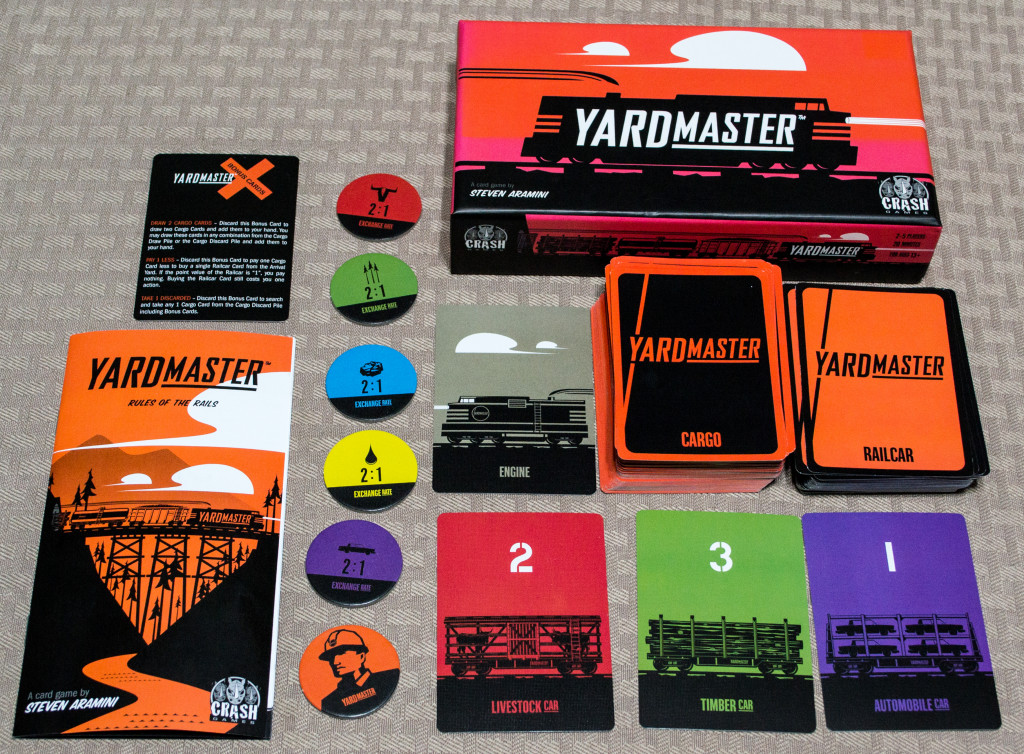If you’ve ever watched Thomas the Tank Engine, then you’ll know that freight cars are cheeky little buggers. How Sir Topham Hat is able to stay in business by having trains pull one or two cars at a time is beyond me, but we’re not here to talk about that today. Rather, we’re going to talk about “Yardmaster”, a game that tasks players with loading their train first by reaching their point goal. Will YOU be very useful, or end up causing confusion and delay? Hey, his words…not mine.
Components
The game includes 40 railcar cards (10 coal, 10 livestock, 10 oil, 10 timber), 52 cargo cards (12 coal, 12 livestock, 12 oil, 12 timber, 4 bonus), 4 engine cards, 4 exchange rate tokens, 1 yardmaster token and the rules.
Setup & Gameplay
The cards are separated into their three deck: engines, railcars, and cargo. Each player gets an engine which is placed face up in front of them (unused ones are discarded). The railcar deck is shuffled and three are drawn face up to form the community arrival yard. The cargo deck is shuffled and each player receives three cargo cards to form their hand. The four exchange tokens are shuffled and each player receives one (extras are placed nearby). The yardmaster token is given to the player to the right of the starting player.
On a player’s turn, they’ll perform two actions from a total of three different options. These actions can be repeated, as well as be performed in any order. The owner of the yardmaster can take three actions instead of two.
1. Draw a cargo card from the deck or the top of the discard pile and add it to your hand. You cannot do the latter if the top card in the discard pile is a bonus card.
2. Buy one railcar from the arrival yard. You’ll discard cargo from your hand equal to the number and color on the railcar you want to buy (a blue 3 railcar costs 3 blue cargo cards). A new card is drawn from the railcar deck to refill the arrival yard. Players can use their exchange rate token (which they keep) to discard cards of a different type for their target color. If you have a red 2:1 token, then you can discard two red cargo cards to make them equal one cargo card color of your choice. After buying a railcar, you’ll place it behind your engine but ONLY if it matches the color or point value of the railcar in front of it. Players can place railcars in a sorting yard to be placed behind their engine later, as a free action.
3. Swap exchange rate tokens with another player or from any extras that may be on the table.
At the end of your turn, you’ll pass the yardmaster token to the right. In a two player game, after using the token, it’s passed to the other player face down. Instead of being used by the other player immediately, they’ll need to wait until the following turn to flip it face up and use it. If you have more than seven cargo cards, then you’ll need to discard down to seven. The player to reach or exceed the point goal (20 in a 2 player game, 18 in a 3 player game, 16 in a 4 player game), wins!
Editor’s Note: The above doesn’t cover all of the rules found in the manual, but should give you an idea as to how the game is played.
The Review
“Yardmaster” reminds me a bit of “UNO”, but with a train theme. In “UNO” you’re attempting to discard cards that match the number or color of the card in the discard pile. Here, you’re laying down sets of cards behind an engine with the same stipulation…that is, the railcar you lay down must be of the same number or color as the one in front of it. This game has mechanics that may appeal to gamers that find “UNO” too simplistic however, what with the inclusion of an exchange rate token, an action points pool, and a yardmaster token that gives the owner an extra action point to use on their turn.
With that said, this isn’t a complex game compared to the others you’ll find on the market. It’ll easily appeal to casual gamer families as well as to hardcore ones looking for a quick filler. There is a bit of luck involved which may turn some off, though there is some strategy in the way you assign your action points and lay out the railcars behind your train. Swapping out and/or using exchange rate tokens can also be strategic in that it’ll allow you to lay down the set you want, but it’ll cost you in one way or another to do it (using an action point to swap the token in the first place, using two cards to perform the swap for one card, etc.).
The price fluctuates between $20 and $25 on Amazon. While part of me considers this price higher than average (I usually see card games market for about $10-$15), the quality of both the card and the box are superb. The artwork is “OK”…sleek in some places, bland in others. All in all, this game does everything it strives to be and more.
Final Verdict: 7/10
—

